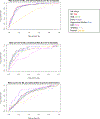Validation of a Machine Learning Model That Outperforms Clinical Risk Scoring Systems for Upper Gastrointestinal Bleeding
- PMID: 31562847
- PMCID: PMC7004228
- DOI: 10.1053/j.gastro.2019.09.009
Validation of a Machine Learning Model That Outperforms Clinical Risk Scoring Systems for Upper Gastrointestinal Bleeding
Abstract
Background & aims: Scoring systems are suboptimal for determining risk in patients with upper gastrointestinal bleeding (UGIB); these might be improved by a machine learning model. We used machine learning to develop a model to calculate the risk of hospital-based intervention or death in patients with UGIB and compared its performance with other scoring systems.
Methods: We analyzed data collected from consecutive unselected patients with UGIB from medical centers in 4 countries (the United States, Scotland, England, and Denmark; n = 1958) from March 2014 through March 2015. We used the data to derive and internally validate a gradient-boosting machine learning model to identify patients who met a composite endpoint of hospital-based intervention (transfusion or hemostatic intervention) or death within 30 days. We compared the performance of the machine learning prediction model with validated pre-endoscopic clinical risk scoring systems (the Glasgow-Blatchford score [GBS], admission Rockall score, and AIMS65). We externally validated the machine learning model using data from 2 Asia-Pacific sites (Singapore and New Zealand; n = 399). Performance was measured by area under receiver operating characteristic curve (AUC) analysis.
Results: The machine learning model identified patients who met the composite endpoint with an AUC of 0.91 in the internal validation set; the clinical scoring systems identified patients who met the composite endpoint with AUC values of 0.88 for the GBS (P = .001), 0.73 for Rockall score (P < .001), and 0.78 for AIMS65 score (P < .001). In the external validation cohort, the machine learning model identified patients who met the composite endpoint with an AUC of 0.90, the GBS with an AUC of 0.87 (P = .004), the Rockall score with an AUC of 0.66 (P < .001), and the AIMS65 with an AUC of 0.64 (P < .001). At cutoff scores at which the machine learning model and GBS identified patients who met the composite endpoint with 100% sensitivity, the specificity values were 26% with the machine learning model versus 12% with GBS (P < .001).
Conclusions: We developed a machine learning model that identifies patients with UGIB who met a composite endpoint of hospital-based intervention or death within 30 days with a greater AUC and higher levels of specificity, at 100% sensitivity, than validated clinical risk scoring systems. This model could increase identification of low-risk patients who can be safely discharged from the emergency department for outpatient management.
Keywords: Artificial Intelligence; Mortality; Prediction; Prognostic Factor.
Copyright © 2020 AGA Institute. Published by Elsevier Inc. All rights reserved.
Conflict of interest statement
Disclosures: The authors disclose no conflicts.
Figures
Comment in
-
RE: Validation of a Machine Learning Model That Outperforms Clinical Risk Scoring Systems for Upper Gastrointestinal Bleeding.Gastroenterology. 2020 Jun;158(8):2307-2308. doi: 10.1053/j.gastro.2020.02.061. Epub 2020 Mar 19. Gastroenterology. 2020. PMID: 32201179 No abstract available.
-
Regarding: Shung et al: Validation of a Machine Learning Model That Outperforms Clinical Risk Scoring Systems for Upper Gastrointestinal Bleeding.Gastroenterology. 2020 Jun;158(8):2308-2309. doi: 10.1053/j.gastro.2020.01.055. Epub 2020 Mar 19. Gastroenterology. 2020. PMID: 32201181 Free PMC article. No abstract available.
-
Reply.Gastroenterology. 2020 Jun;158(8):2309-2310. doi: 10.1053/j.gastro.2020.03.044. Epub 2020 Mar 28. Gastroenterology. 2020. PMID: 32234305 No abstract available.
References
-
- Longstreth GF. Epidemiology of hospitalization for acute upper gastrointestinal hemorrhage: a population-based study. Am J Gastroenterol 1995;90:206–10. - PubMed
-
- Yavorski RT, Wong RK, Maydonovitch C, et al. Analysis of 3,294 cases of upper gastrointestinal bleeding in military medical facilities. Am J Gastroenterol 1995;90:568–73. - PubMed
-
- Vreeburg EM, Snel P, de Bruijne JW, et al. Acute upper gastrointestinal bleeding in the Amsterdam area: incidence, diagnosis, and clinical outcome. Am J Gastroenterol 1997;92:236–43. - PubMed
Publication types
MeSH terms
Grants and funding
LinkOut - more resources
Full Text Sources
Medical
Miscellaneous




